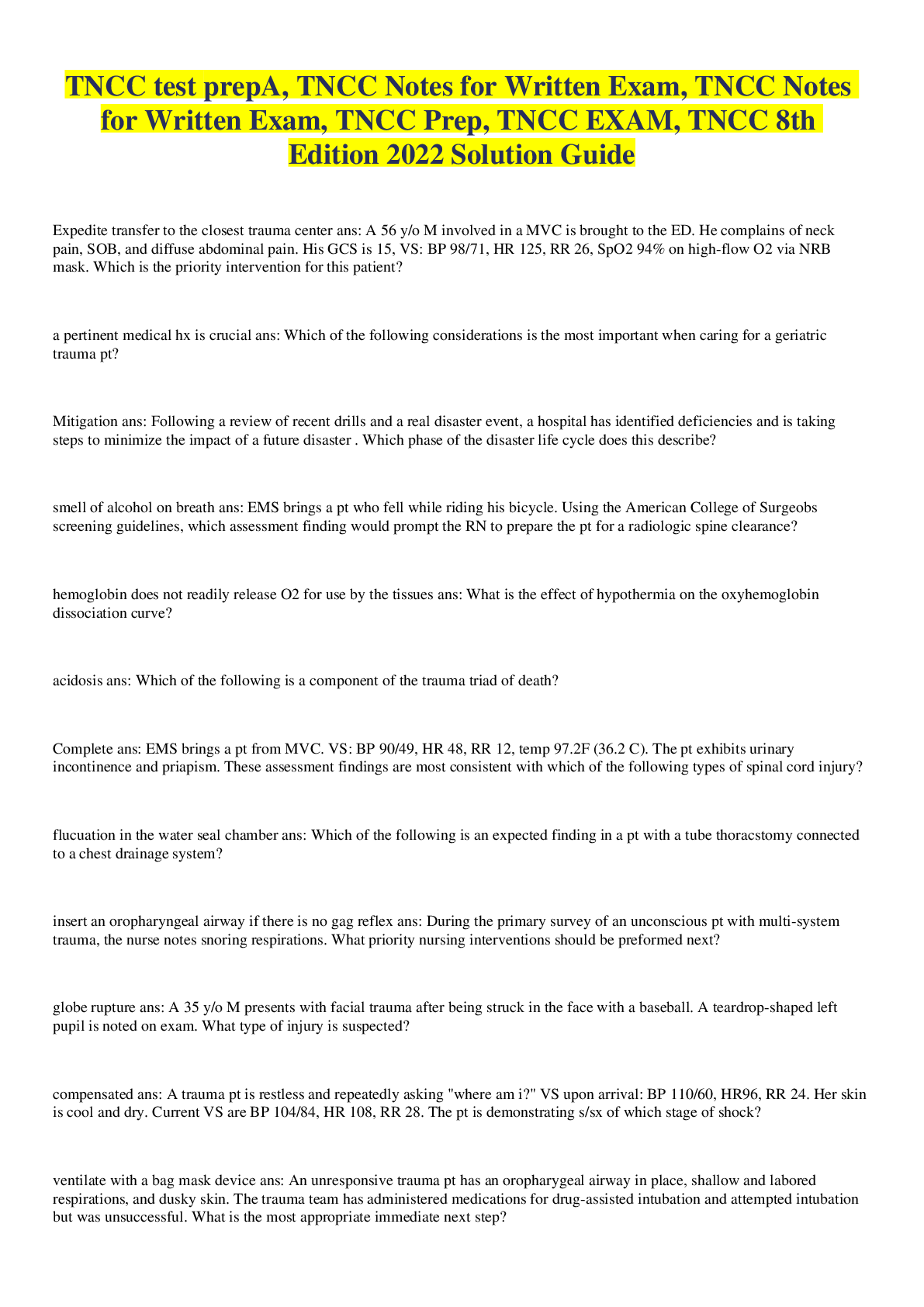*NURSING > QUESTIONS & ANSWERS > TNCC test prepA, TNCC Notes for Written Exam, TNCC Notes for Written Exam, TNCC Prep, TNCC EXAM, TNC (All)
TNCC test prepA, TNCC Notes for Written Exam, TNCC Notes for Written Exam, TNCC Prep, TNCC EXAM, TNCC 8th Edition
Document Content and Description Below
Expedite transfer to the closest trauma center - ✔✔A 56 y/o M pt involved in a motor vehicle crash is brought to the ED of a rural critical access facility. He complains of neck pain, SOB, and di... ffuse abd pain. His GCS is 15. His VS: BP 98/71, HR 125, RR 26, SpO2 94% on high-flow O2 via NRB mask. Which of the following is the priority intervention for this patient? a pertinent medical hx is crucial - ✔✔Which of the following considerations is the most important when caring for a geriatric trauma pt? Mitigation - ✔✔Following a review of recent drills and a real disaster event, a hospital has identified deficiencies and is taking steps to minimize the impact of a future disaster . Which phase of the disaster life cycle does this describe? Multiple requests for water - ✔✔EMS brings a pt who fell while riding his bicycle. Using the American College of Surgeobs screening guidelines, which assessment finding would prompt the RN to prepare the pt for a radiologic spine clearance? hemoglobin does not readily release O2 for use by the tissues - ✔✔What is the effect of hypothermia on the oxyhemoglobin dissociation curve? acidosis - ✔✔Which of the following is a component of the trauma triad of death? Complete - ✔✔EMS brings a pt from MVC. VS: BP 90/49, HR 48, RR 12, temp 97.2F (36.2 C). The pt exhibits urinary incontinence and priapism. These assessment findings are most consistent with which of the following types of spinal cord injury?flucuation in the water seal chamber - ✔✔Which of the following is an expected finding in a pt with a tube thoracstomy connected to a chest drainage system? insert an oropharyngeal airway if there is no gag reflex - ✔✔During the primary survey of an unconscious pt with multi-system trauma, the nurse notes snoring respirations. What priority nursing interventions should be preformed next? globe rupture - ✔✔A 35 y/o M presents with facial trauma after being struck in the face with a baseball. A teardrop-shaped left pupil is noted on exam. What type of injury is suspected? compensated - ✔✔A trauma pt is restless and repeatedly asking "where am i?" VS upon arrival: BP 110/60, HR96, RR 24. Her skin is cool and dry. Current VS are BP 104/84, HR 108, RR 28. The pt is demonstrating s/sx of which stage of shock? ventilate with a bag mask device - ✔✔An unresponsive trauma pt has an oropharygeal airway in place, shallow and labored respirations, and dusky skin. The trauma team has administered medications for drug-assisted intubation and attempted intubation but was unsuccessful. What is the most appropriate immediate next step? within 24 hrs of trauma - ✔✔When is the tertiary survey completed fora trauma pt? pressure - ✔✔An intubated and sedated pt in the ED has multiple extremity injuries with the potential for causing compartment syndrome. What is the most reliable indication of compartment syndrome in a patient who is unconscious? worsening pneumothorax - ✔✔Which of the following is possible complication of positive-pressure ventilation? pelvic stability - ✔✔the most reassuring finding for a male pt with hip pain after a fall is which of the following? narrowed - ✔✔Which of the following pulse pressures indicate early hypovolemic shock?dysrhythmias - ✔✔Patients with a crush injury should be monitored for which of the following conditions? subdural hematoma - ✔✔Tearing of the bridging veins is most frequently associated with which brain injury? straight cath for urine sample - ✔✔A 20 y/o M presents to the ED complaining of severe lower abd pain after landing hard on the bicycle cross bars while preforming an aerial BMX maneuver. Secondary assessment reveals lower abd tenderness and scrotal ecchymosis. Which of the following orders would the RN question? placental abruption - ✔✔You are caring for a pt who was involved in a MVC and is 32 weeks pregnant. Findings of your secondary survey include abd pain on palpation, fundal ht at the costal margin, and some dark bloody show. Varying accelerations and decelerations are noted on cariocgraphy. These findings are most consistent with which of the following? it can worsen cord damage from an unstable spinal injury - ✔✔Which of the following is true about the log-roll? defusings - ✔✔All of these are considered a critical communication point in trauma care EXCEPT which of the following? pulse oximetry and capnography - ✔✔What bedside monitoring parameters are used to assess for adequacy of O2 and effectiveness of ventilation? padding the upper back while stabilizing the cervical spine - ✔✔Caregivers carry in a 2 y/o into the ED who fell out of a second-story window. The pt is awake and crying with increased work of breathing and pale skin. Which of the following interventions has the highest priority? bowel - ✔✔Which of the following injuries is LEAST likely to be promptly identified?Initiate transfer to a trauma center - ✔✔A pt is brought to the ED of a rural hospital following a highspeed MVC. When significant abd and pelvic injuries are noted in the primary survey, which of the following is the priority interventions? bardycardia and absent motor function below the level of injury - ✔✔A pt with a complete spinal cord injury in neurogenic shock will demonstrate hypotension and which other clinical signs? apply splint and elevate above the level of the heart - ✔✔a 37 y/o F has a deformity of the L wrist after a fall. She is reluctant to move her hand due to pain. Which of the following is the most appropriate intervention? the aorta is torn at its attachment with the ligamentum arteriosum - ✔✔which of the following occurs during the third impact of a motor vehicle crash? Report your suspicion of maltreatment in accordance with local regulations - ✔✔a 5 y/o child presents to the ED with bruises to the upper arm and buttocks in various stages of healing and multiple small, clean, round burns to the back. There are no abnormalities found based on the pediatric assessment triangle or primary survey. Which of the following is the priority survey. Which of the following is the priority nursing intervention? to guage end-organ perfusion and tissue hypoxia - ✔✔Why is a measure of serum lactate obtained in the initial assessment of a trauma patient? elevating the extremity to the level of the heart - ✔✔A pt with a lower extremity fracture complains of severe pain and tightness in his calf, minimally by pain medications. Which of the following is the priority nursing intervention? velocity - ✔✔What factor contributes most to the kinetic energy of a body in motion? subdural hematoma - ✔✔An elderly patient with a history of anticoagulant use presents after a fall at home today. She denies any loss of consciousness. She has a hematoma to her forehead and complains of headache, dizziness, and nausea. What is the most likely cause of her symptoms?fat embolism - ✔✔a pt has been in the ED for several hrs waiting to be admitted. He sustained multiple rib fractures and a femur fracture after a fall. He has been awake, alert, and complaining of leg pain. His wife reported that he suddenly became anxious and confused. Upon reassessment, the pt is restless with respiratory distress and petechiae to his neck. The pt is exhibiting s/sx most commonly associated with which of the following conditions? nausea and vomiting - ✔✔Which of the following is a late sign of increased intracranial pressure? serial FAST exams - ✔✔a 49 y/o restrained driver involved in a MVC presents to the trauma center complaining of abd, pelvic, and bilateral lower extremity pain. VS are stable. The nurse can anticipate all of these after a negative FAST exam EXCEPT which of the following? pericardiocentesis - ✔✔Which of the following is NOT considered goal-directed therapy for cardiogenic shock? endotracheal tube - ✔✔The trauma nurse knows that placing a bariatric patient in a ramped position providers better visualization during the insertion of which device? increased work of breathing? - ✔✔which of the following assessment findings differentiates a tension pneumothorax from a simple pneumothorax? calcium - ✔✔if a pt has received multiple transfusions of banked blood preserved with citrate, which electrolyte is most likely to drop and require supplementation? identifying individuals who made mistakes during the traumatic event - ✔✔Which of the following is NOT considered a benefit of debriefings? 500 mL/hr - ✔✔You are treating a 27 y/o M in respiratory distress who was involved in a house fire. Calculating TBSA burned is deferred due to the need for emergent intubation. At what rate should you begin fluid resuscitation? advanced age - ✔✔Which of the following is most likely to contribute to inadequate oxygenation and ventilation?a 52 y/o diabetic male with a partial thickness burn to the left lower leg - ✔✔Which of the following patients warrants referral to a burn center? dressing removal - ✔✔A patient arrives with a large open chest wound after being assaulted with a machete. Prehospital providers placed a nonporous dressing over the chest wound and taped it on three sides. he is now showing signs of anxiety, restlessness, severe respiratory distress, cyanosis and decreasing blood pressure. Which of the following is the MOST appropriate immediate intervention? after a physical examination if the pt has no radiologic abnormalities on CT - ✔✔EMS arrives with the intoxicated driver of a car involved in a MVC. EMS reports significant damage to the drivers side of the car. The pt is asking to have the cervical collar removed. When it is appropriate to remove the cervical collar? MARCH - ✔✔Which of the following mnemonics can help the nurse prioritize care for a trauma patient with massive uncontrolled hemorrhage? What is kinematics? - ✔✔A branch of mechanics (energy transfer) that refers to motion and does not consider the concepts of force and mass of the object or body. What is Newton's First Law? - ✔✔A body at rest will remain at rest. A body in motion will remain in motion until acted on by an outside force. What is the Law of Conservation of Energy? - ✔✔Energy can neither be created nor destroyed. It is only changed from one form to another. What is Newton's Second Law? - ✔✔Force equals mass multiplied by acceleration of deceleration. What is kinetic energy (KE)? - ✔✔KE equals 1/2 the mass (M) multiplied by the velocity squared. What is the Mnemonic for the Initial Assessment? - ✔✔A = Airway with simultaneous cervical spine protectionB = Breathing C = Circulation D = Disability (neurologic status) E = Expose/Environmental controls (remove clothing and keep the patient warm) What is the Mnemonic for the Secondary Assessment? - ✔✔F = Full set of VS/Focused adjuncts (includes cardiac monitor, urinary catheter, and gastric tube)/Family presence G = Give comfort measures (verbal reassurance, touch, and pharmacologic and nonpharmacologic management of pain). H = Hx and Head-to-toe assessment I = Inspect posterior surfaces Where do you listen to auscultate breath sounds? - ✔✔Auscultate the lungs bilaterally at the second intercostal space midclavicular line and at the fifth intercostal space at the anterior axillary line. What are the late signs of breathing compromise? - ✔✔- Tracheal deviation - JVD What are signs of ineffective breathing? - ✔✔- AMS - Cyanosis, especially around the mouth - Asymmetric expansion of chest wall - Paradoxical movement of the chest wall during inspiration and expiration - Use of accessory muscles or abdominal muscles or both or diaphragmatic breathing - Sucking chest wounds - Absent or diminished breath sounds - Administer O2 via NRB or assist ventilations with a bag-mask device, as indicated - Anticipate definitive airway management to support ventilation. Upon initial assessment, what type of oxygen should be used for a pt breathing effectively? - ✔✔A tightfitting nonrebreather mask at 12-15 lpm.What intervention should be done if a pt presents with effective circulation? - ✔✔- Insert 2 large caliber IV's - Administer warmed isotonic crystalloid solution at an appropriate rate What are signs of ineffective circulation? - ✔✔- Tachycardia - AMS - Uncontrolled external bleeding - Pale, cool, moist skin - Distended or abnormally flattened external jugular veins - Distant heart sounds What are the interventions for Effective/Ineffective Circulation? - ✔✔- Control any uncontrolled external bleeding by: - Applying direct pressure over bleeding site - Elevating bleeding extremity - Applying pressure over arterial pressure points - Using tourniquet (last resort). - Cannulate 2 large-caliber IV's and initiate infusions of an isotonic crystalloid solution - Use warmed solution - Use pressure bags to increase speed of IVF infusion - Use blood administration tubing for possible administration of blood - Use rapid infusion device based on protocol - Use NS 0.9% in same tubing as blood product - IV = surgical cut-down, central line, or both. - Blood sample to determine ABO and Rh group - IO in sternum, legs, arms or pelvis - Administer blood products - PASG (without interfering with fluid resuscitation)How do you assess Mnemonic "D"? - ✔✔DISABILITY A = Alert V = Verbal P = Pain U = Unresponsive - GCS - PERRL? - Determine presence of lateralizing signs including: - Unilateral deterioration in motor movements or unequal pupils - Symptoms that help to locate area of injury in brain What are the interventions for Disability? - ✔✔- If assessment indicates a decreased LOC, conduct further investigation during secondary focused assessments - If pt is not alert or verbal, continue to monitor for any compromise to ABC's - If pt demonstrates signs of herniation or neurologic deterioration, consider hyperventilation. What is assessed and intervened for Expose/Environmental Controls? - ✔✔- Remove clothing - Ensure appropriate decontamination if exposed to hazardous material - Keep pt warm - Keep clothing for evidence What is the first thing assessed under the Secondary Assessment? - ✔✔FULL SET VS / FOCUSED ADJUNCTS / FAMILY PRESENCE - ABCDE should be completed - Labs, X-rays, CT, Foley, - Family Presence What is the second thing assessed under the Secondary Assessment? - ✔✔GIVE COMFORT MEASURES- Talking to pt - Pharmacologic/Nonpharmacologic pain management - Observe for physical signs of pain What is assessed under the Mnemonic "H"? - ✔✔HISTORY / HEAD-TO-TOE ASSESSMENT - MIVT - M = Mechanism of injury - I = Injuries sustained - V = Vital Signs - T = Treatment - Pt generated information - PMH - Head-to-toe assessment What is assessed under the Mnemonic "I"? - ✔✔INSPECT POSTERIOR SURFACES - While maintaining C-spine, logroll pt with assistance to inspect back, flanks, buttocks and posterior thighs. - Palpate vertebral column for deformity and areas of tenderness - Assess rectum for presence/absence of tone, presence of blood What she be done after the Secondary Assessment? - ✔✔Reassess: - Primary survey, - VS - Pain - Any injuries What are factors that contribute to ineffective ventilation? - ✔✔- AMS - LOC - Neurologic injury- Spinal Cord Injury - Intracranial Injury - Blunt trauma - Pain caused by rib fractures - Penetrating Trauma - Preexisting hx of respiratory diseases - Increased age What medications are used during intubation? - ✔✔LOAD Mnemonic: L = Lidocaine O = Opioids A = Atropine D = Defasiculating agents What are the Rapid Sequence Intubation Steps? - ✔✔PREPARATION: - gather equipment, staffing, etc. PREOXYGENATION: - Use 100% O2 (prevent risk of aspiration). PRETREATMENT: - Decrease S/E's of intubation PARALYSIS WITH INDUCTION: - Pt has LOC, then administer neuromuscular blocking agent PROTECTION AND POSITIONING: - Apply pressure over cricoid cartilage (minimizes likelihood of vomiting and aspiration PLACEMENT WITH PROOF - Each attempt NOT to exceed 30 seconds, max of 3 attempts. Ventilate pt 30-60 seconds between attempts. - After intubation, inflate the cuff - Confirm tube placement w/exhaled CO2 detector.POSTINTUBATION MANAGEMENT: - Secure ET tube - Set ventilator settings - Obtain Chest x-ray - Continue to medicate - Recheck VS and pulse oxtimetry What is a Combitube? - ✔✔A dual-lumen, dual-cuff airway that can be placed blindly into the esophagus to establish an airway. If inadvertently placed into trachea, it can be used as a temporary ET tube. There are only two sizes: small adult and larger adult. What is a Laryngeal Mask Airway? - ✔✔Looks like an ET tube but is equipped with an inflatable, elliptical, silicone rubber collar at the distal end. It is designed to cover the supraglottic area. ILMA, does not require laryngoscopy and visualization of the chords. What is Needle Cricothyrotomy - ✔✔Percutaneous transtracheal ventilation. (temporary) Complications include: - inadequate ventilation causing hypoxia - hematoma formation - esophageal perforation - aspiration - thyroid perforation - subcutaneous emphysema What is Surgical Cricothyrotomy? - ✔✔Making an incision in cricothyroid membrane and placing a cuffed endo or trach tube into trachea. This is indicated when other methods of airway management have failed and pt cannot be adequately ventilated and oxygenated.Complications include: - Aspiration - Hemorrhage or hematoma formation or both - Lac to trachea or esophagus - Creation of a false passage - Laryngeal stenosis How do you confirm ET Tube/Alternative Airway Placement? - ✔✔- Visualization of the chords - Using bronchoscope to confirm placement - Listening to breath sounds over the epigastrum and chest walls while ventilating the pt - CO2 detector - Esophageal detection device - Chest x-ray How do you inspect the chest for adequate ventilation? - ✔✔Observe: - mental status - RR and pattern - chest wall symmetry - any injuries - patient's skin color (cyanosis?) - JVD or tracheal deviation? (Tension pneumothorax) What are you looking for when auscultating lung sounds? - ✔✔Absence of BS: - Pneumothorax - Hemothorax - Airway Obstruction Diminished BS: - Splinting or shallow BS may be a result of painWhat are you looking for when percussing the chest? - ✔✔Dullness: - hemothorax Hyperresonance - Pneumothorax What are you looking for when palpating the chest wall, clavicles and neck? - ✔✔- Tenderness - Swelling - subcutaneous emphysema - step-off deformities = These may indicate: esophageal, pleural, tracheal or bronchial injuries. Palpate trachea above suprasternal notch. Tracheal deviation may indicate a tension pneumothorax or massive hemothorax. What is the DOPE mnemonic? - ✔✔D - Displaced tube O - Obstruction: Check secretions or pt biting tube P - Pneumothorax: Condition may occur from original trauma or barotrauma from ventilator E - Equipment failure: pt may have become detached from equipment or there's a kink in the tubing Explain Hypovolemic Shock. - ✔✔Most common to affect a trauma pt cause by hypovolemia.. Hypovolemia, a decrease in amount of circulating blood volume, may result from significant loss of whole blood because of hemorrhage or from loss of semipermeable integrity of cellular membrane leading to leakage of plasma and protein from intravascular space to the interstitial space (as in a burn). Some causes: - Blood loss - Burns, etc. Explain Cardiogenic Shock. - ✔✔Syndrome that results from ineffective perfusion caused by ineffective perfusion caused by inadequate contractility of cardiac muscle.Some causes: - MI - Blunt cardiac injury - Mitral valve insufficiency - dysrhythmias - Cardiac Failure Explain Obstructive Shock. - ✔✔Results from inadequate circulating blood volume because of an obstruction or compression of great veins, aorta, pulmonary arteries, or heart itself. Some causes: - Cardiac tamponade (may compress the heart during diastole to such and extent that atria cannot adequately fill, leading to decreased stroke volume). - Tension pneumothorax may lead to inadequate stroke volume by displacing inferior vena cava and obstructing venous return to right atrium. - Air embolus may lead to obstruction of pulmonary artery and subsequent obstruction to right ventricular outflow during systole, with resulting obstructive shock Explain Distributive Shock. - ✔✔Results from disruption in SNS control of the tone of blood vessels, which leads to vasodilation and maldistribution of blood volume and flow. (Neurogenic and Septic Shock). Neurogenic shock may result from injury to spinal cord in cervical or upper thoracic region. Spinal shock = areflexia and flaccidity associated with lower motor neuron involvement in complete cord injuries; reflexes return with resolution of spinal shock. Septic shock from bacteremia is distributive shock. Endotoxins and other inflammatory mediators cause vasodilation, shunting of blood in microcirculation, and other perfusion abnormalities. What is vascular response? - ✔✔As blood volume decreases, peripheral blood vessels vasoconstrict as a result of sympathetic stimulation via inhibition of baroreceptors. Arterioles constrict to increase TPR and BP.What is renal response? - ✔✔Renal ischemia activates release of renin. Kidneys do not receive adequate blood supply, renin is release into circulation. Renin causes angiotensinogen, normal plasma protein, to release angiotensin I. Angiotensin-converting enzyme from the lungs converts into angiotensin II. Angiotensin II causes: - Vasoconstriction of arterioles and some veins - Stimulation of sympathetic nervous system - Retention of water by kidneys - Stimulation of release of aldosterone from the adrenal cortex (sodium retention hormone) *Decreased urinary output = early sign renal hypoperfusion and an indicator that there's systemic hypoperfusion. Explain adrenal gland response. - ✔✔When adrenal glands are stimulated by SNS, release of catecholamines (epinephrine and norepinephrine) from adrenal medulla will increase. Epi stimulates receptors in heart to increase force of cardiac contraction (positive inotropy) and increase HR (positive chronotropy) to improve cardiac output, BP and tissue perfusion. Shock stimulates hypothalamus to release corticotropin-releasing hormone that stimulates pituitary to release ACTH that stimulates adrenal gland to release cortisol. Effect of cortisol release is elevation in blood sugar and increased insulin resistance and gluconeogenesis, hepatic process to produce more sugar. Cortisol also causes renal retention of water and sodium, a compensatory mechanism to conserve body water.Explain Hepatic Response. - ✔✔Liver can store excess glucose as glycogen. As shock progresses, glycogenolysis is activated by epi to break down glycogen into glucose. In a compensatory response to shock, hepatic vessels constrict to redirect blood flow to other vital areas. Explain Pulmonary Response. - ✔✔Tachypnea happens for 2 reasons: 1. Maintain acid-base balance 2. Maintain increased supply of oxygen * Metabolic acidosis from anaerobic metabolism will be a stimulus for the lungs to increase rate of ventilation. Increased RR is an attempt to correct acidosis + augments oxygen supply to maximize oxygen delivery to alveoli. Explain Irreversible Shock. - ✔✔Shock uncompensated or irreversible stages will cause compromises to most body systems. - Inadequate venous return - inadequate cardiac filling - decreased coronary artery perfusion - Membranes of lysosomes breakdown within cells and release digestive enzymes that cause intracellular damage. How would you assess someone in hypovolemic shock? - ✔✔(Use Initial Assessment) and then: Inspect: - LOC - Rate and quality of respirations - External bleeding? - Skin color and moisture- Assess jugular veins and peripheral veins Auscultate: - BP - Pulse pressure - Breath sounds - Heart sounds - Bowel sounds Percuss: - Chest and abdomen Palpate: - Central pulse (carotid or femoral) - Positive inotropic effect (force of contraction) may be evidence by a bounding central pulse - Palpate peripheral pulses - Palpate skin temp and moisture Diagnostic Procedures: - Xrays and other studies - Labs Planning and Implementation - Oxygen - IV's with warmed replacement fluids - Control external bleeding with direct pressure - Elevate LE's - NGT - Foley - Monitor and pulse oximeter - Monitor for development of coagulopathies - Surgery? ICP is a reflection of what three volumes? What happens when one increases? - ✔✔1. Brain2. CSF 3. Blood within the nonexpansible cranial vault As volume of one increases, the volume of another decreases to maintain ICP within normal range. As ICP rises, CPP decreases, leading to cerebral ischemia and potential for hypoxia and lethal secondary insult. Hypotensive pt w/marginally elevated ICP can be harmful. Slightly elevated BP could protect against brain ischemia in a pt with high ICP. Cerebral ischemia can lead to increased concentration of CO2 and decreased concentration of O2 in cerebral vessels. CO2 dilates cerebral blood vessels = increase blood volume and ICP. What are the early signs and symptoms of increased ICP? - ✔✔- Headache - N/V - Amnesia regarding events around the injury - Altered LOC - Restlessness, drowsiness, changes in speech, or loss of judgement What are the late observable signs of symptoms of increased ICP? - ✔✔- Dilated, nonreactive pupil - Unresponsiveness to verbal or painful stimuli - Abnormal motor posturing patterns - Widening pulse pressure - Increased systolic blood pressure - Changes in RR and pattern - Bradycardia What is Cushing's phenomenon or Cushing's Reflex? - ✔✔Triad of progressive HTN, bradycardia and diminished respiratory effort. What are the two types of herniation that occurs with ICP? - ✔✔1. Uncal herniation2. Central or transtentorial herniation Why does herniation occur? What are the symptoms? - ✔✔Because of uncontrolled increases in ICP. S/E's - Unilateral or bilateral pupillary dilation - AsyDimmetric pupillary reactivity - Abnormal motor posturing - Other evidence of neurologic deterioration Define uncal herniation. - ✔✔The uncus (medial aspect of the temporal lobe) is displaced over the tentorium into the posterior fossa. This herniation is the more common of the two types of herniation syndromes. Define central or transtentorial herniation. - ✔✔A downward movement of the cerebral hemispheres with herniation of the diencephalon and midbrain through the elongated gap of the tentorium. Disruptions of the bony structures of the skull can result in what? - ✔✔Displaced or nondisplaced fx's causing CSF leakage b/c of lac to the dura mater, creating a passage for CSF. CSF leaks through the nose (rhinorrhea) or the ears (otorrhea). A potential entrance for invading bacteria. Also: meningitis or encephalitis or brain abscess Define Minor Head Trauma. - ✔✔GCS 13-15 Define Moderate Head Trauma - ✔✔Postresuscitative state with GCS 9-13. Define Severe Head Trauma. - ✔✔Postresuscitative state with GCS score of 8 or less.What is a concussion and its signs and symptoms? - ✔✔A temporary change in neurologic function that may occur as a result of minor head trauma. S/S: - Transient LOC - H/A - Confusion and disorientation - Dizziness - N/V - Loss of memory - Difficulty with concentration - Irritability - Fatigue What are the signs and symptoms of postconcussive syndrome? - ✔✔- Persistent H/A - Dizziness - Nausea - Memory impairment - Attention deficit - Irritability - Insomnia - Impaired judgement - Loss of libido - Anxiety - Depression What is diffuse axonal injury and its signs and symptoms? - ✔✔(DAI) is widespread, rather than localized, through the brain. Diffuse shearing, tearing and compressive stresses from rotational or accerleration/deceleration forces resulting in microscopic damage primarily to axons within the brain. S/S: - Immediate unconsciousne [Show More]
Last updated: 1 year ago
Preview 1 out of 93 pages
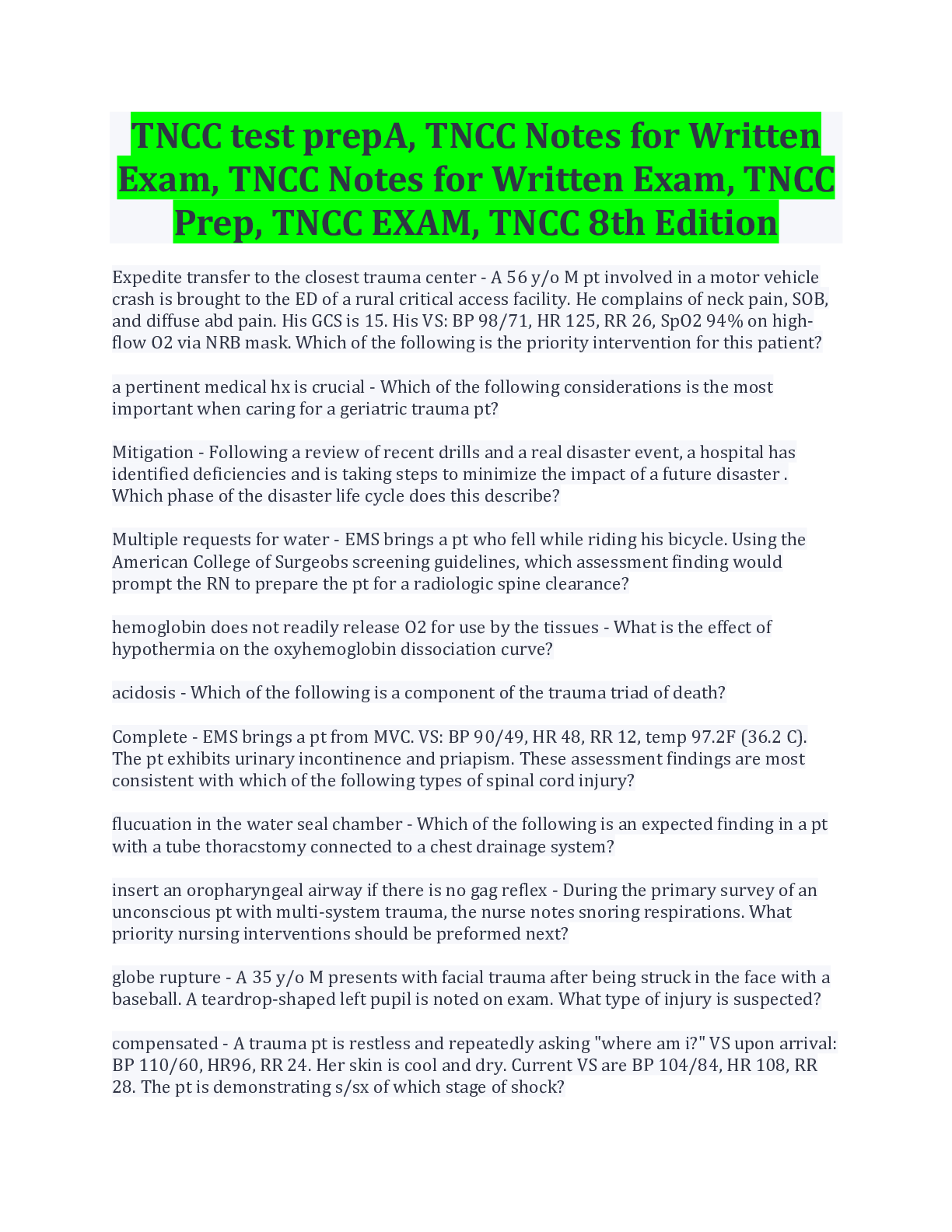
Also available in bundle (1)
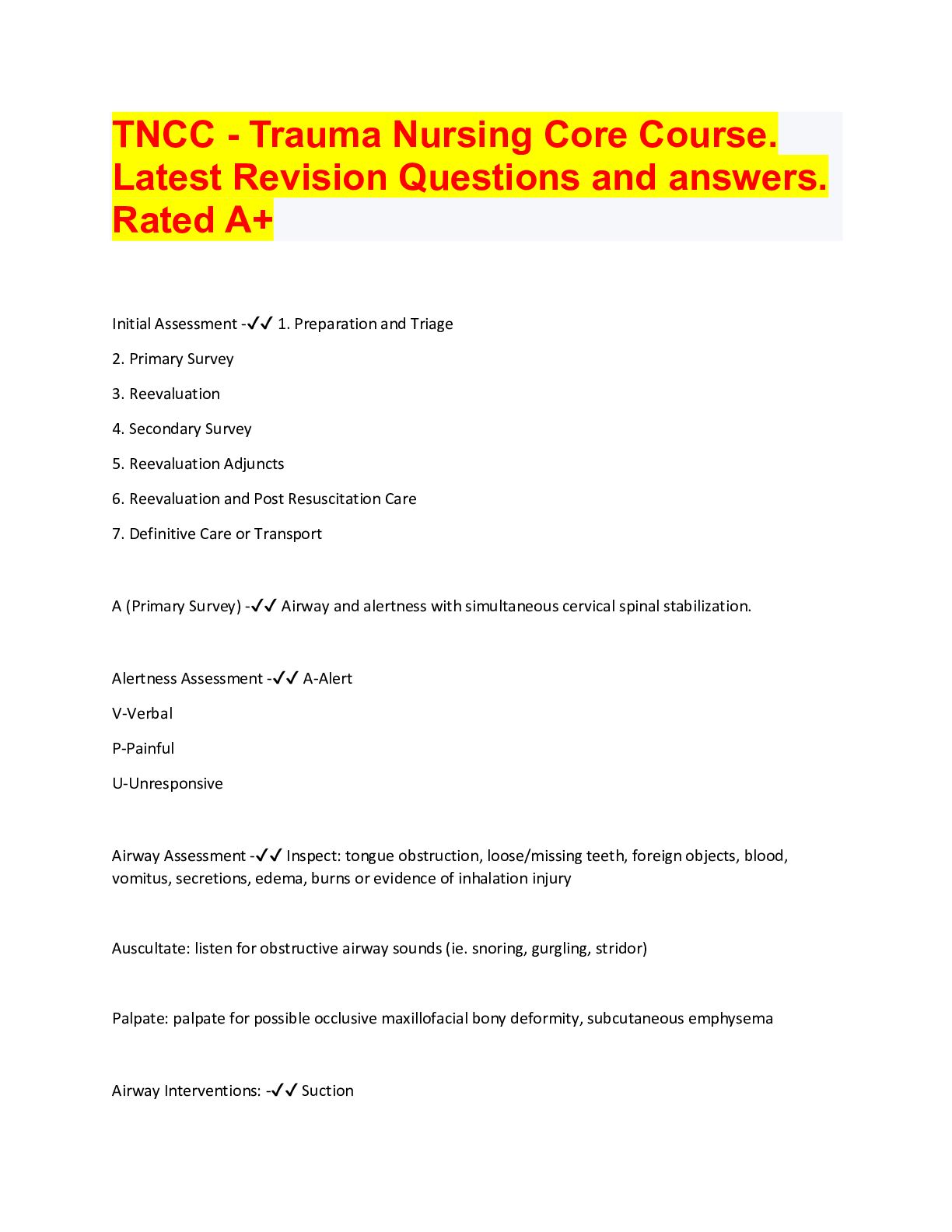
TNCC BUNDLE. QUESTIONS WITH 100% CORRECT ANSWERS. ALL GRADED A+ 99% APPROVED PASS RATE
THE BUNDLE is a compilation of latest and most examinable test questions with their answers. 100% approved. Download to score
By bundleHub Solution guider 1 year ago
$28
18
Reviews( 0 )
Document information
Connected school, study & course
About the document
Uploaded On
Jul 14, 2022
Number of pages
93
Written in
Additional information
This document has been written for:
Uploaded
Jul 14, 2022
Downloads
0
Views
211



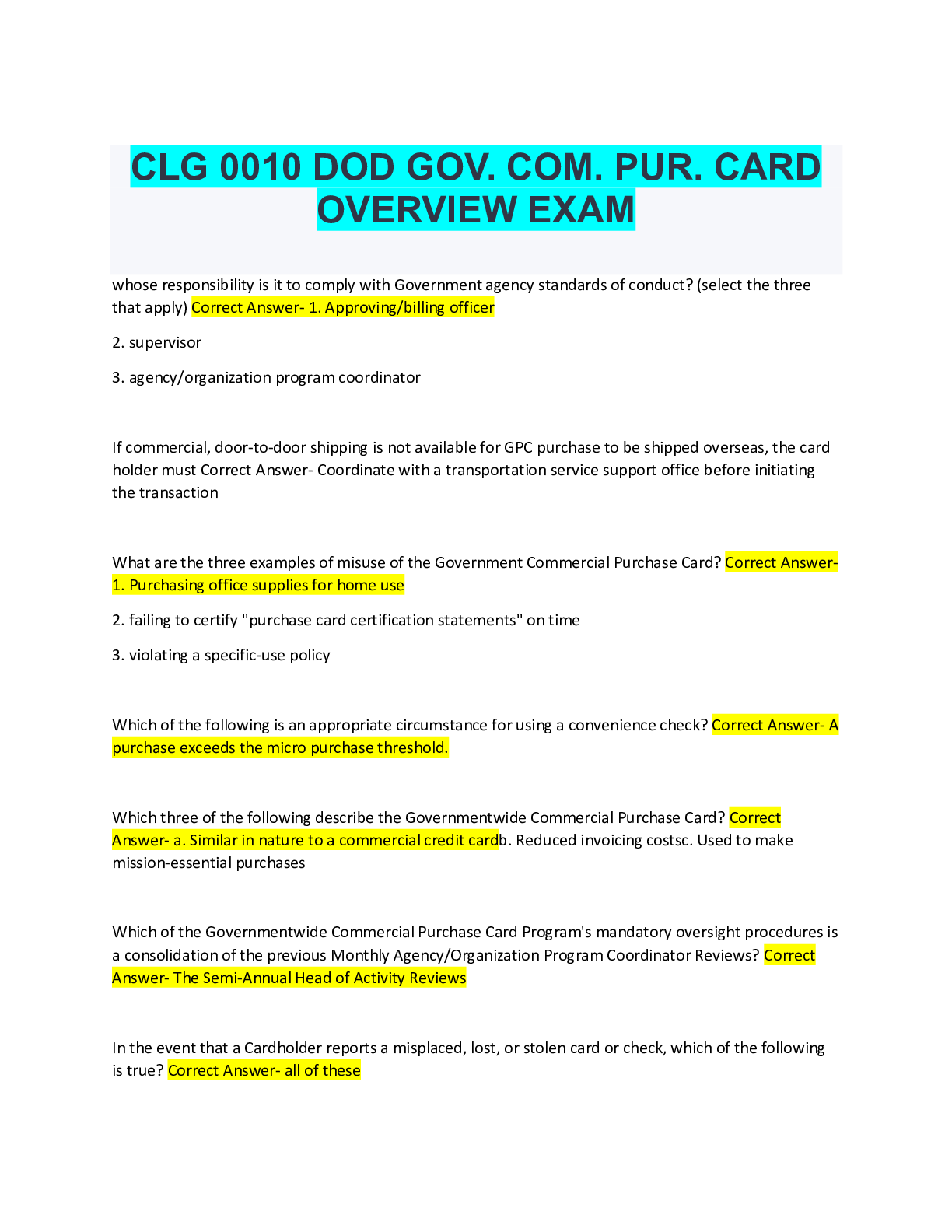


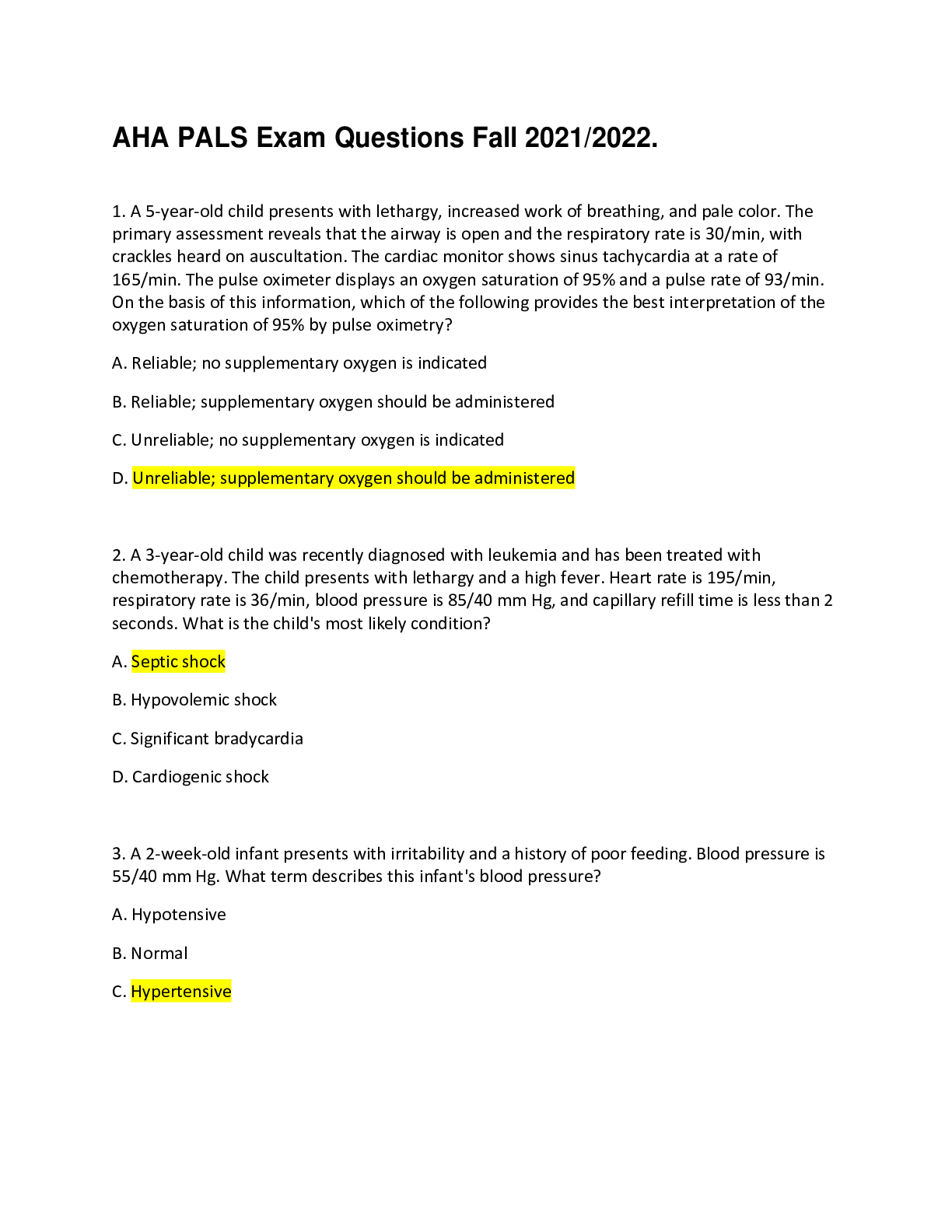

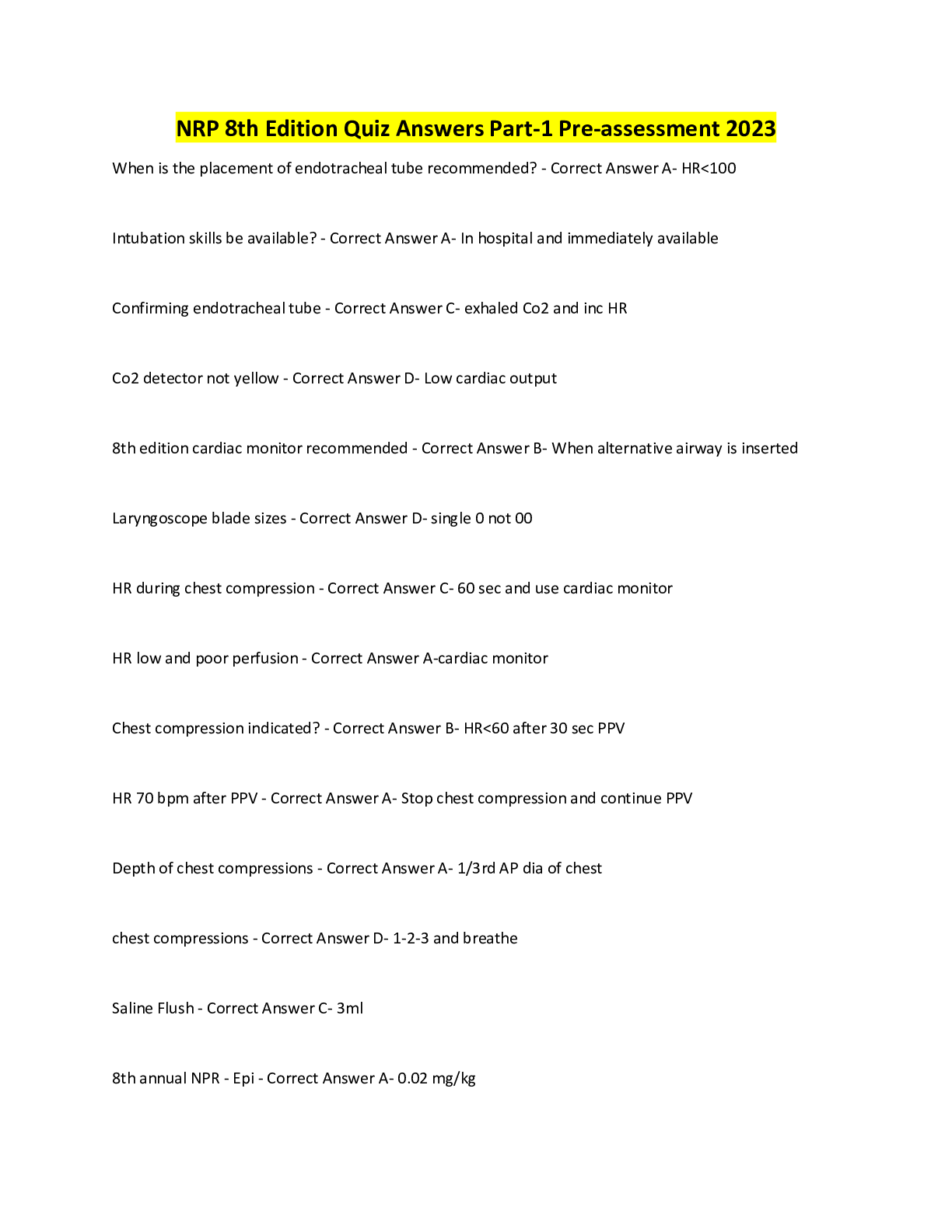

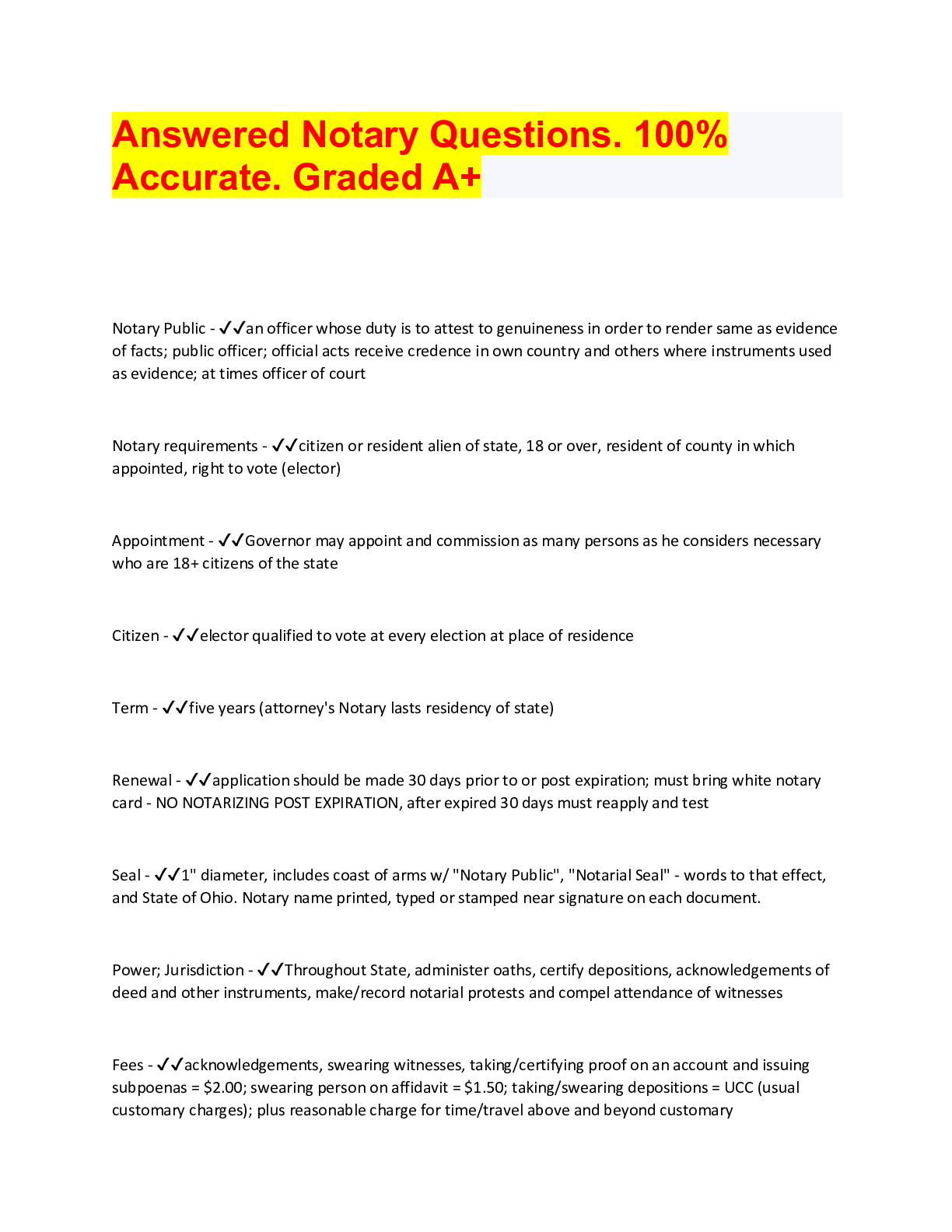

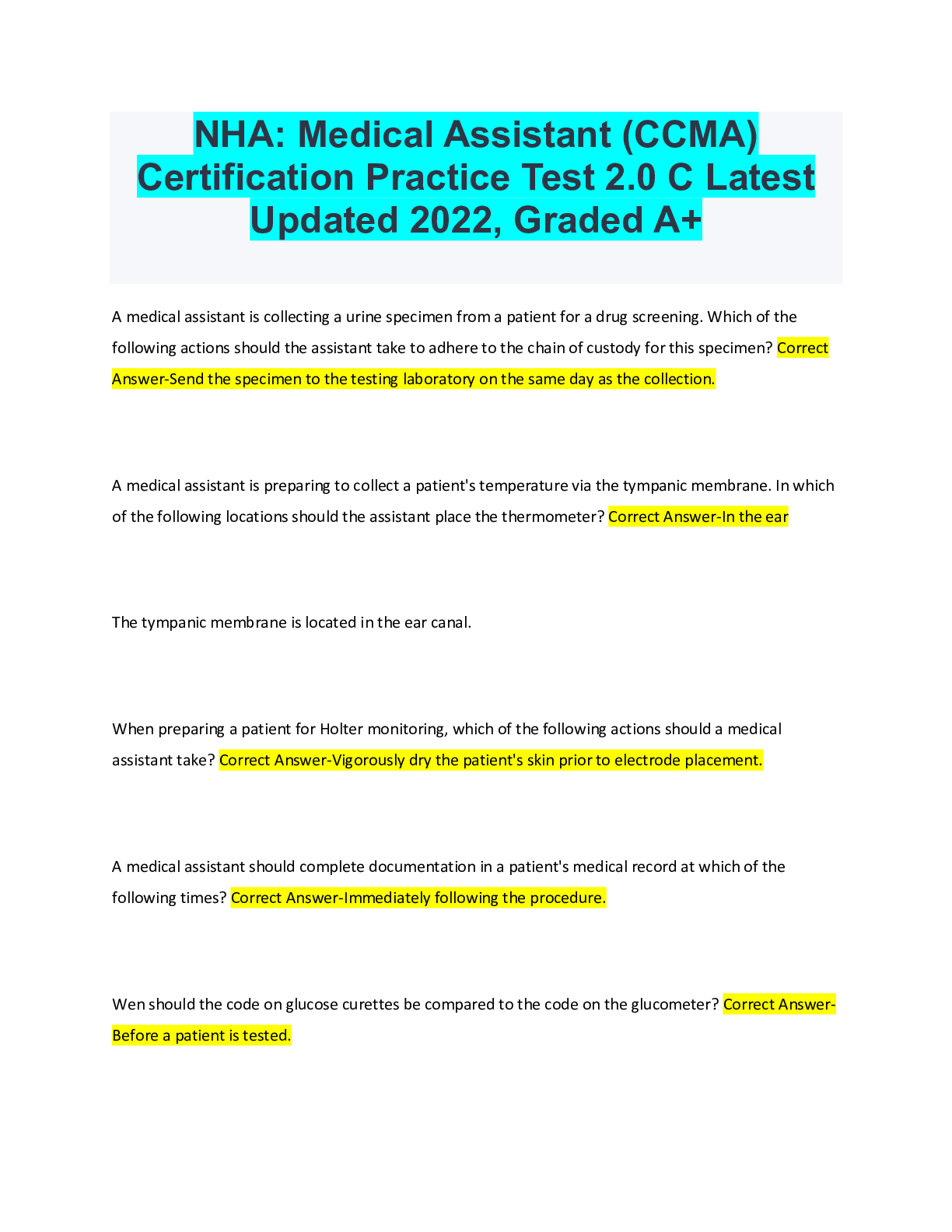
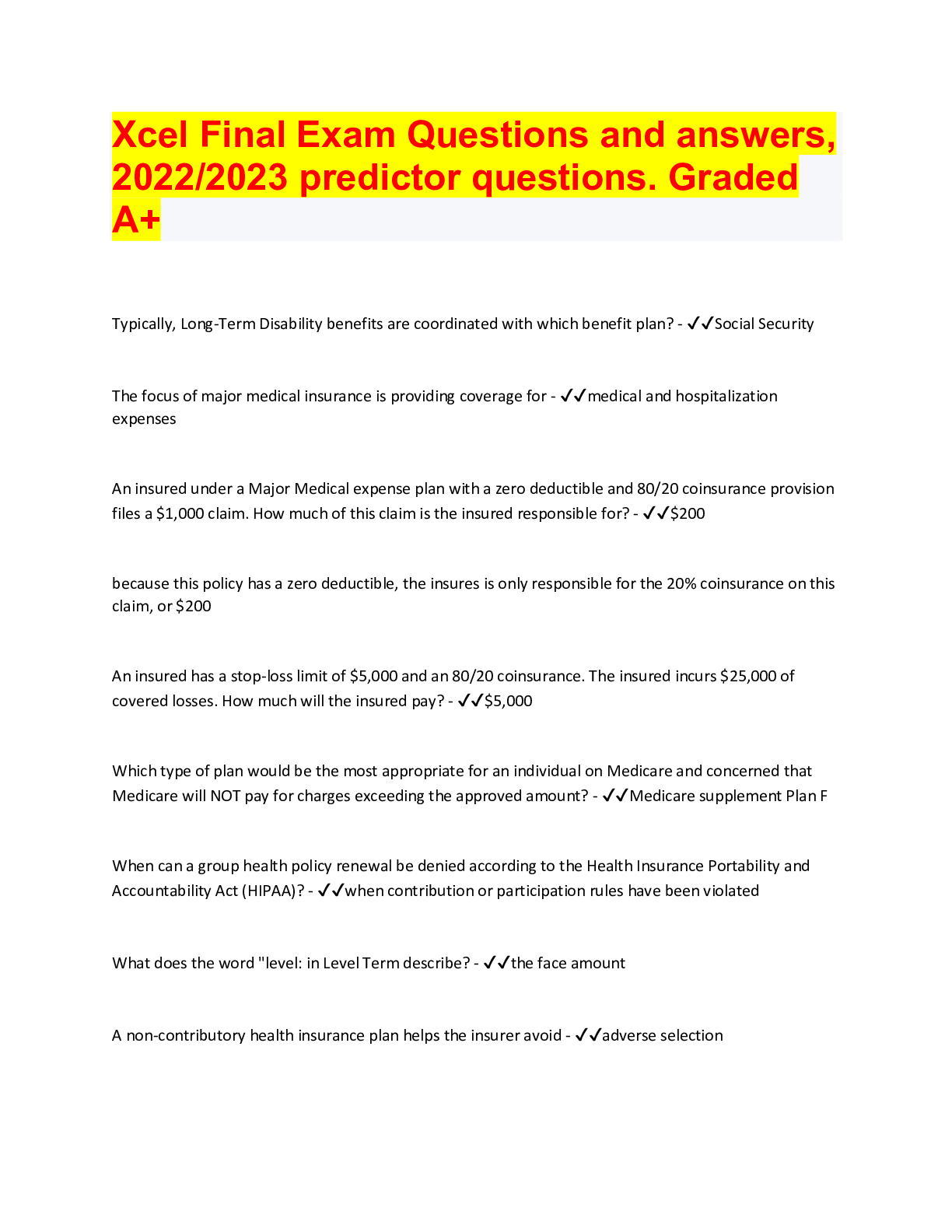
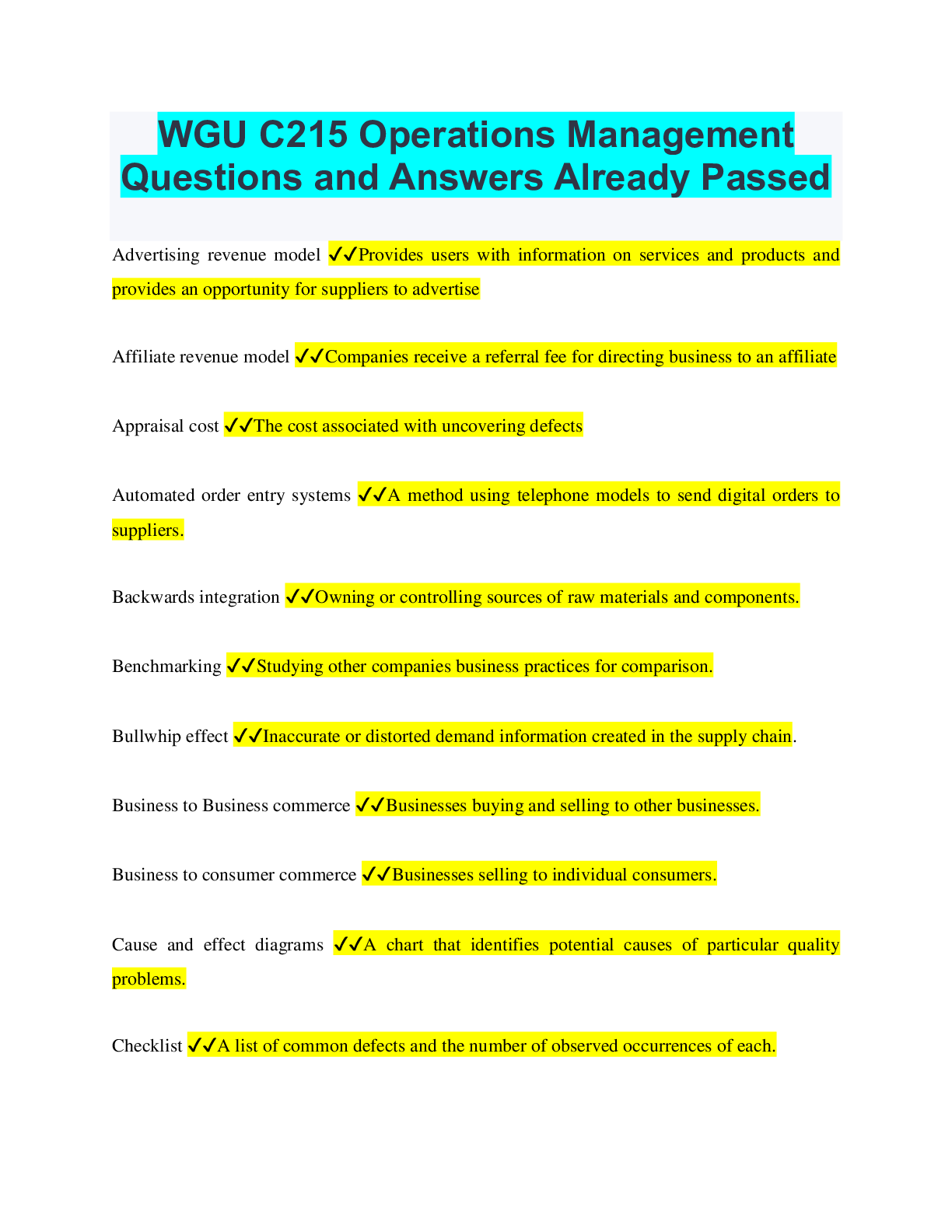
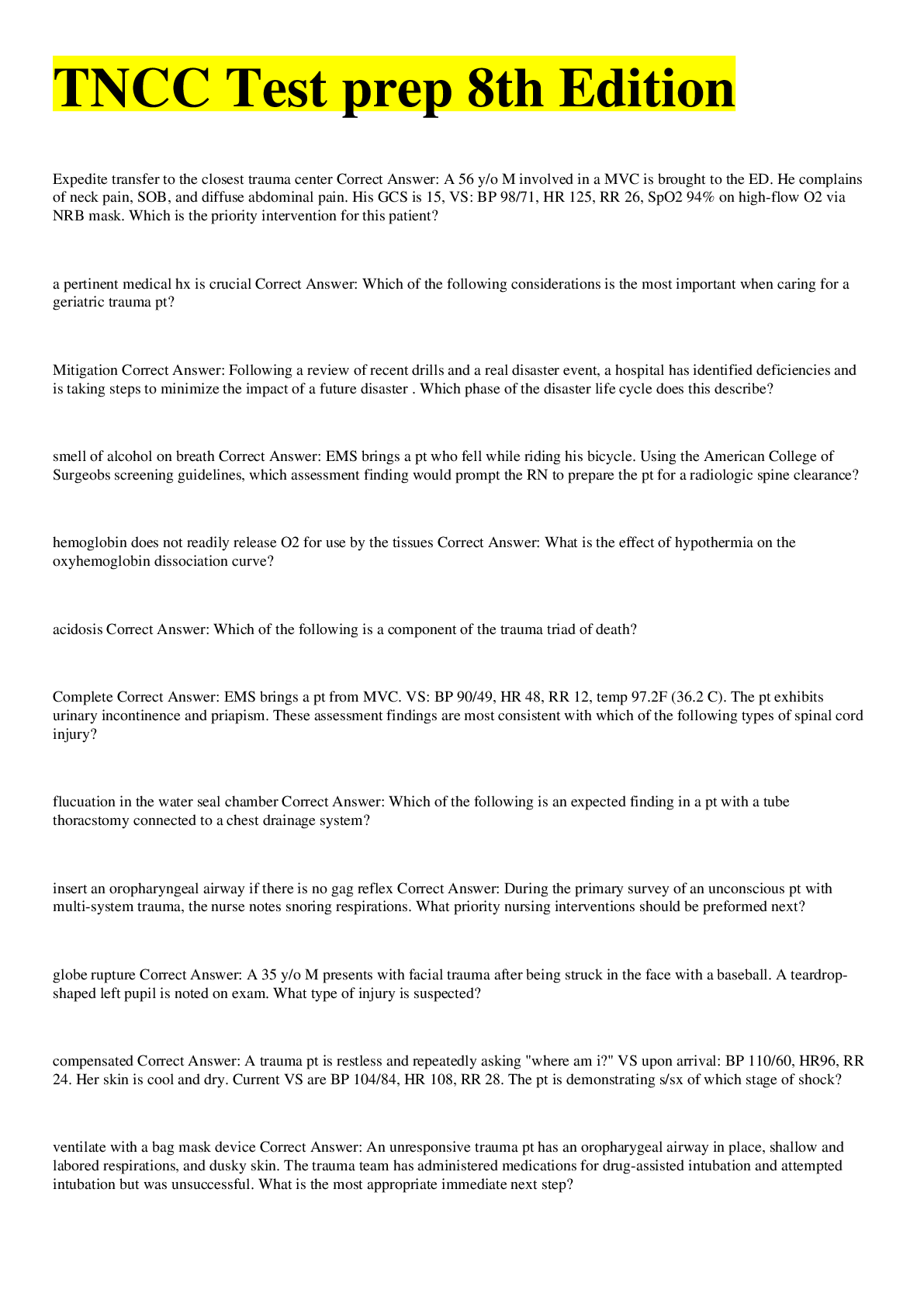
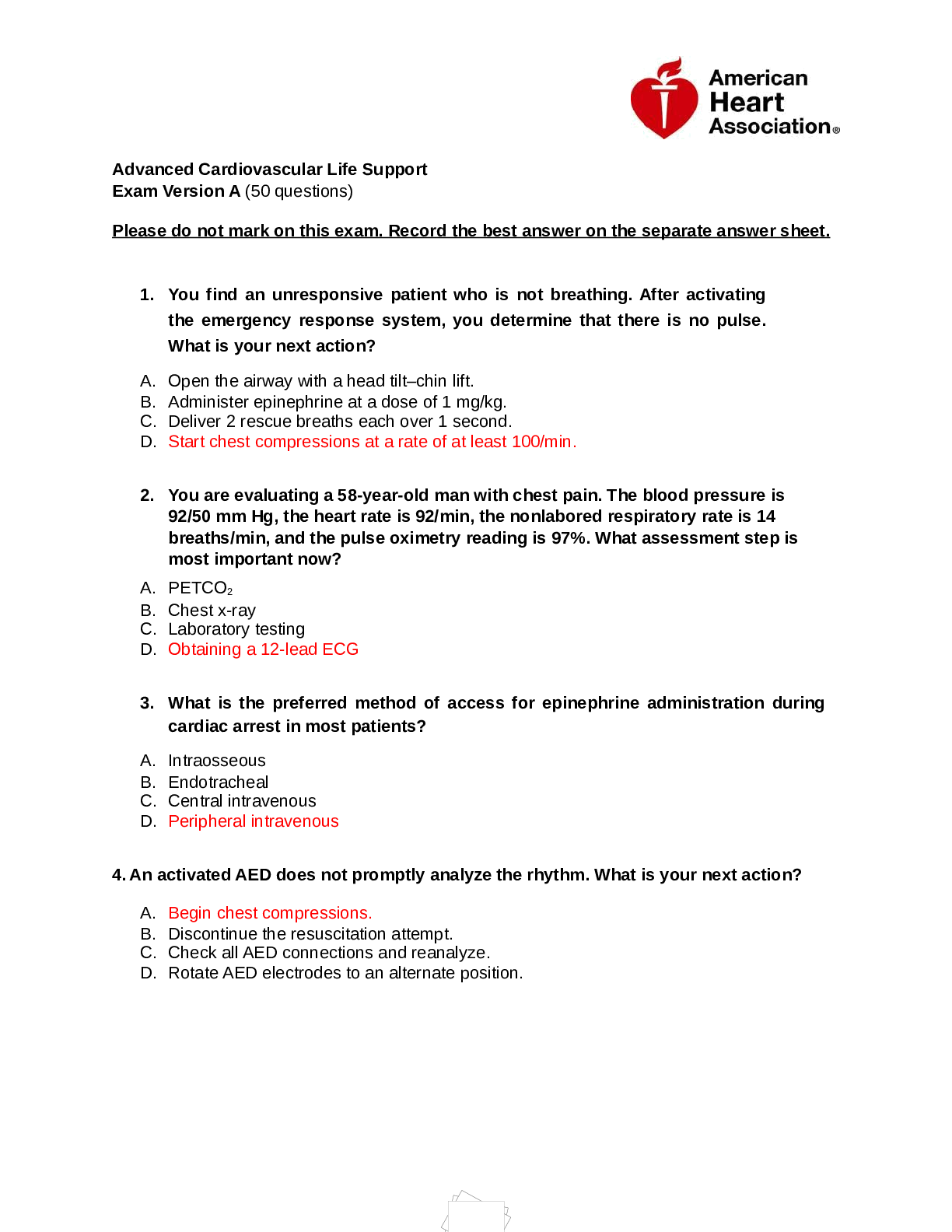
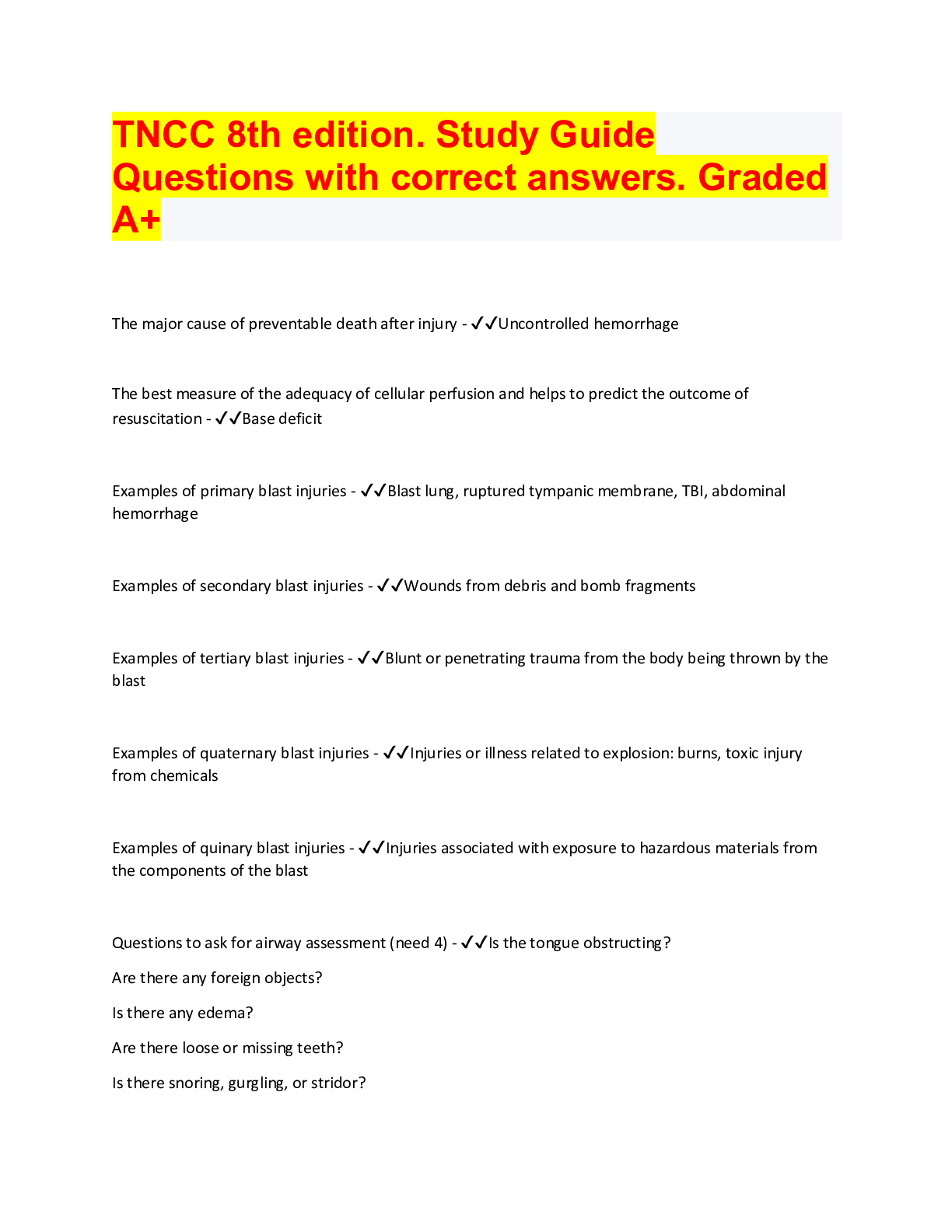
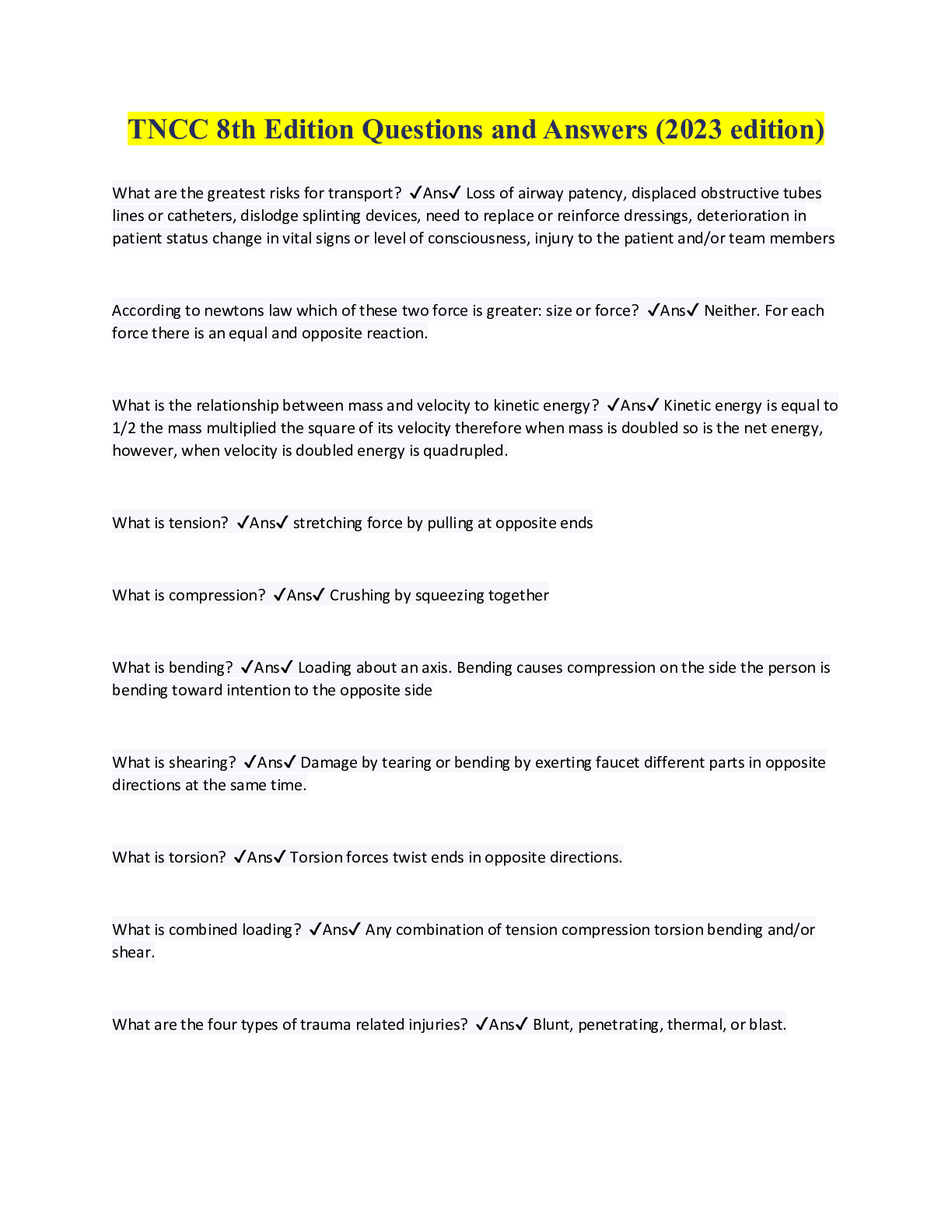
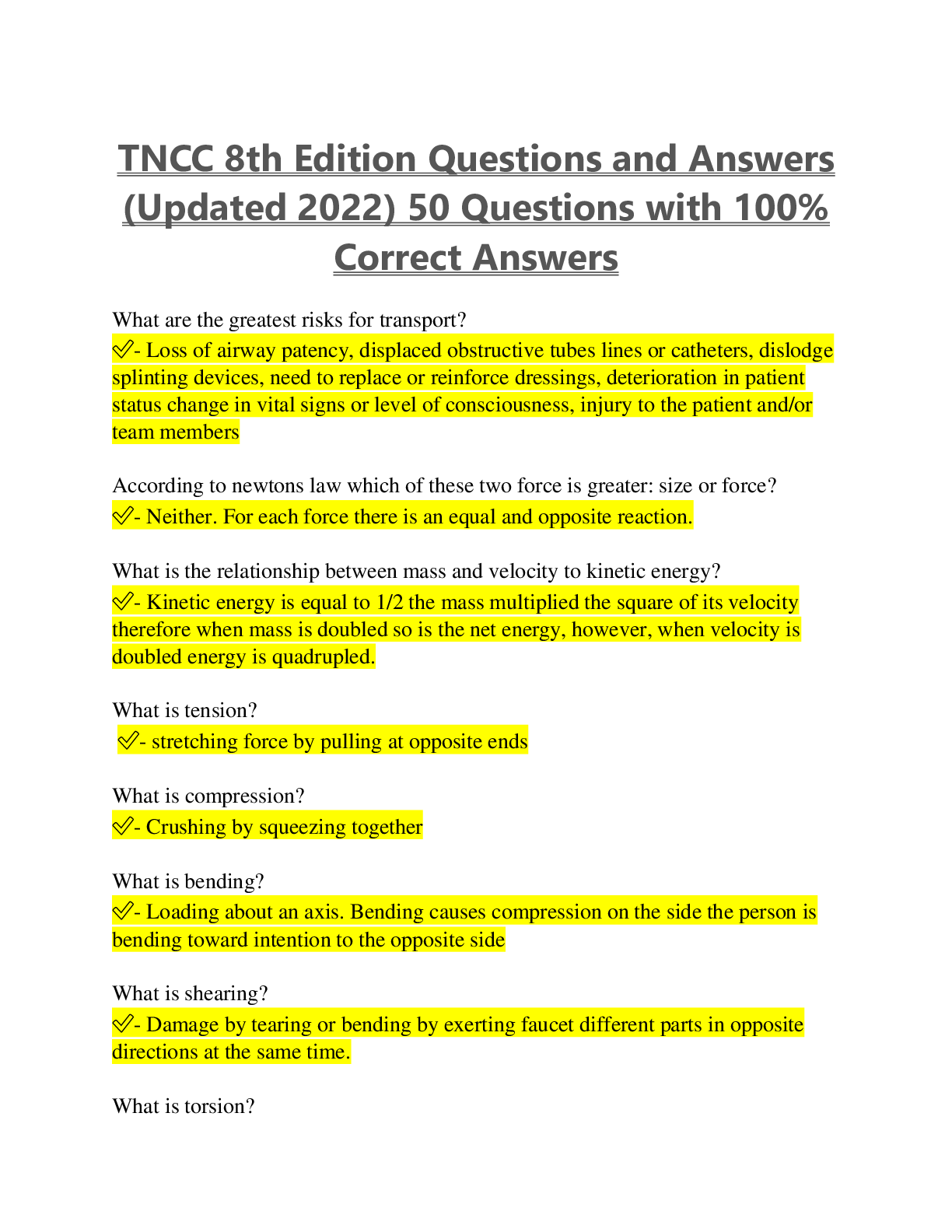
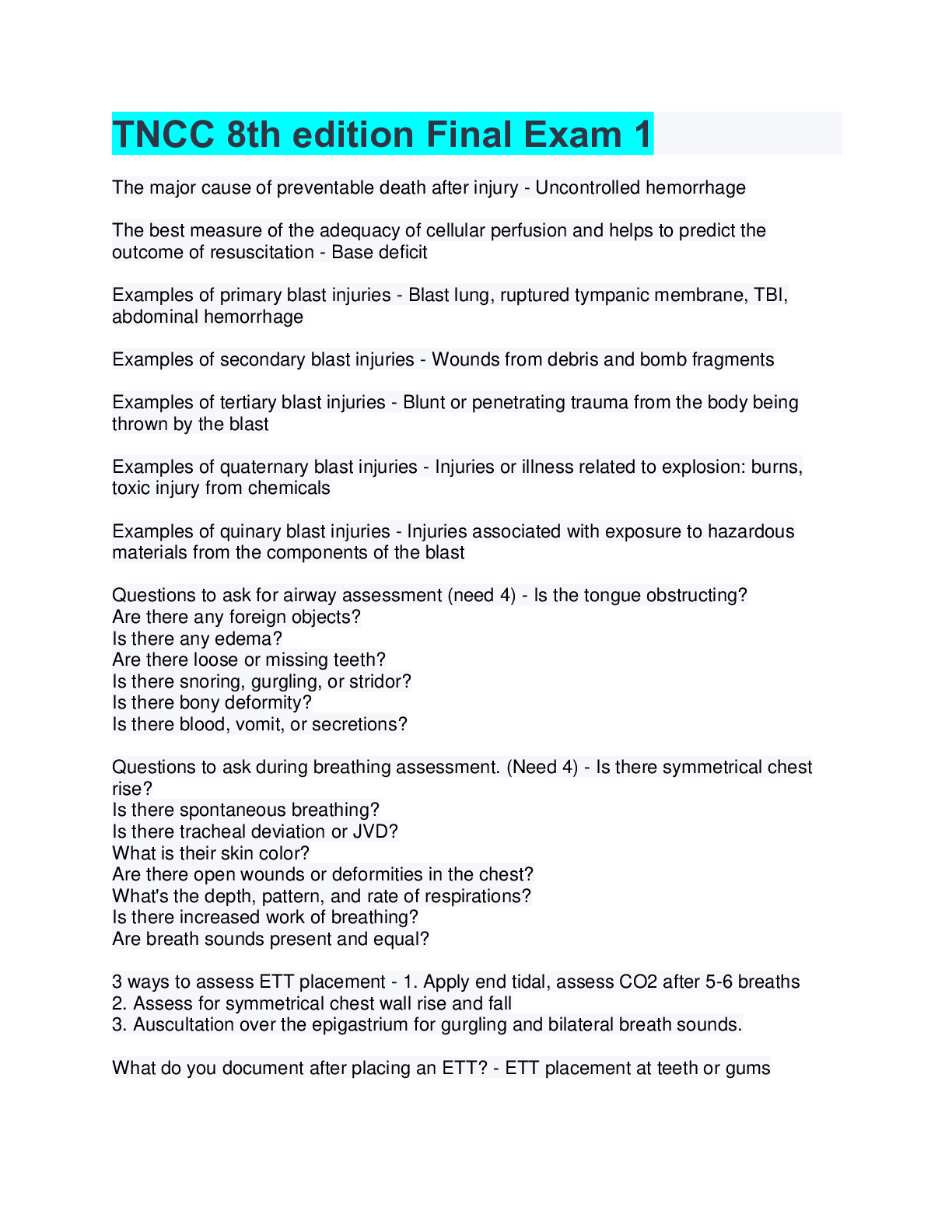

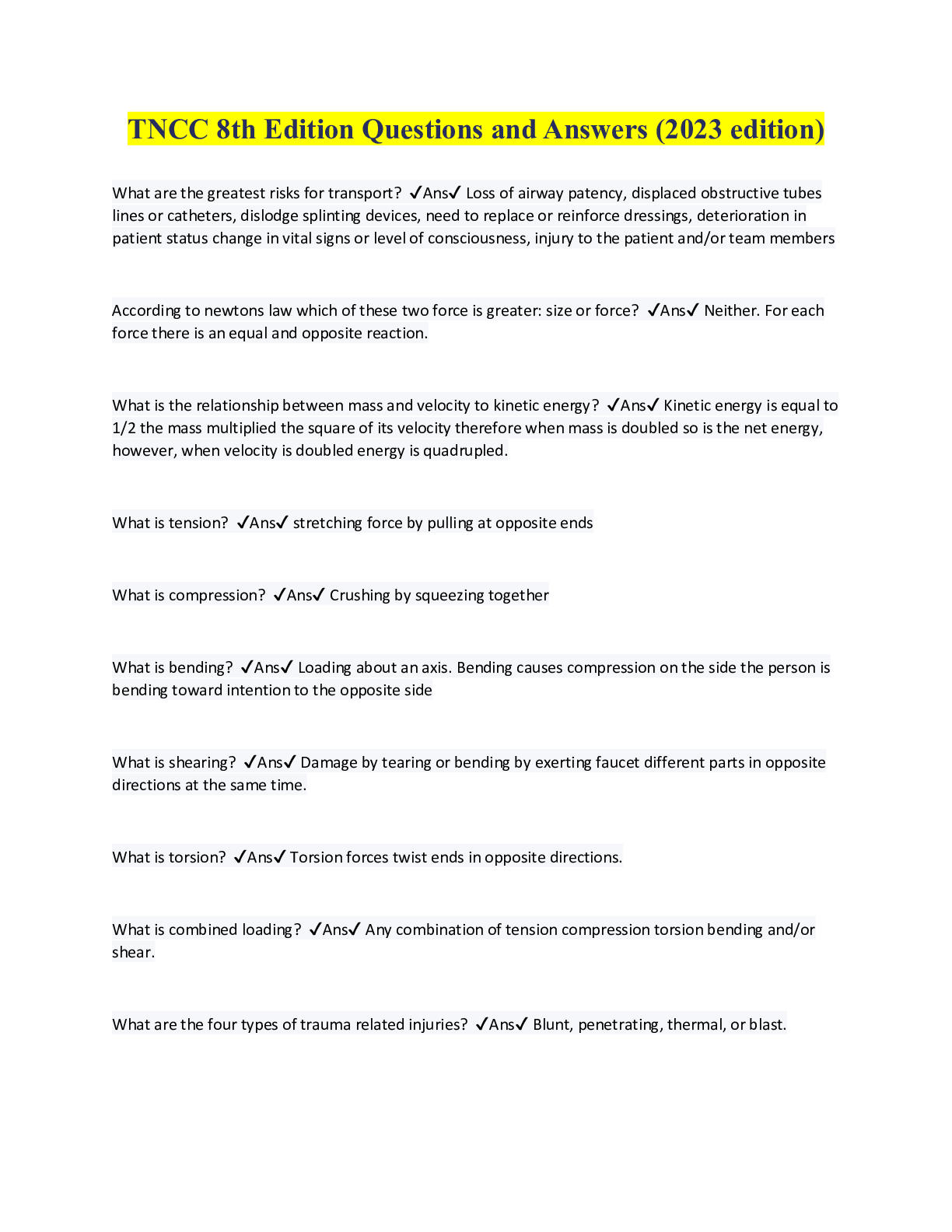


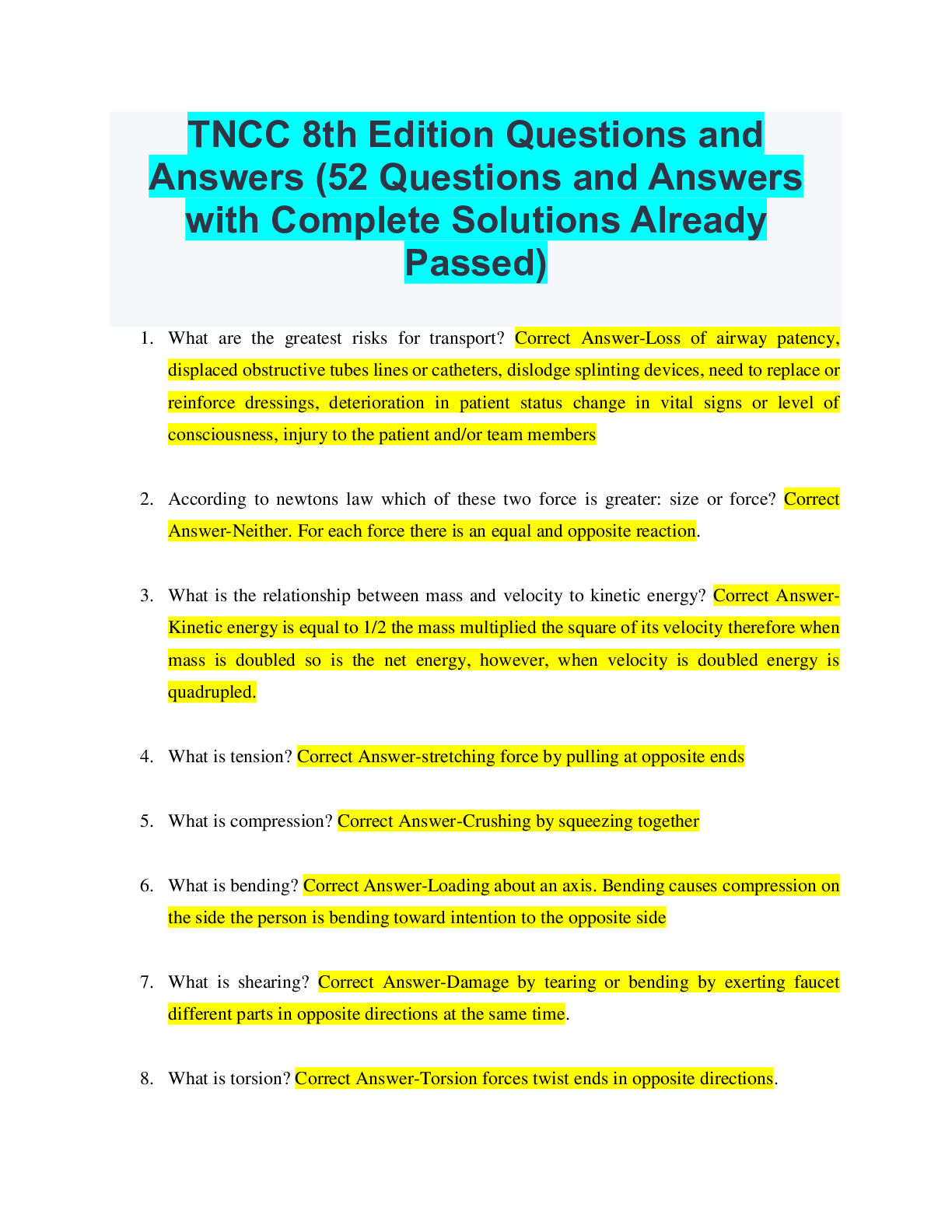


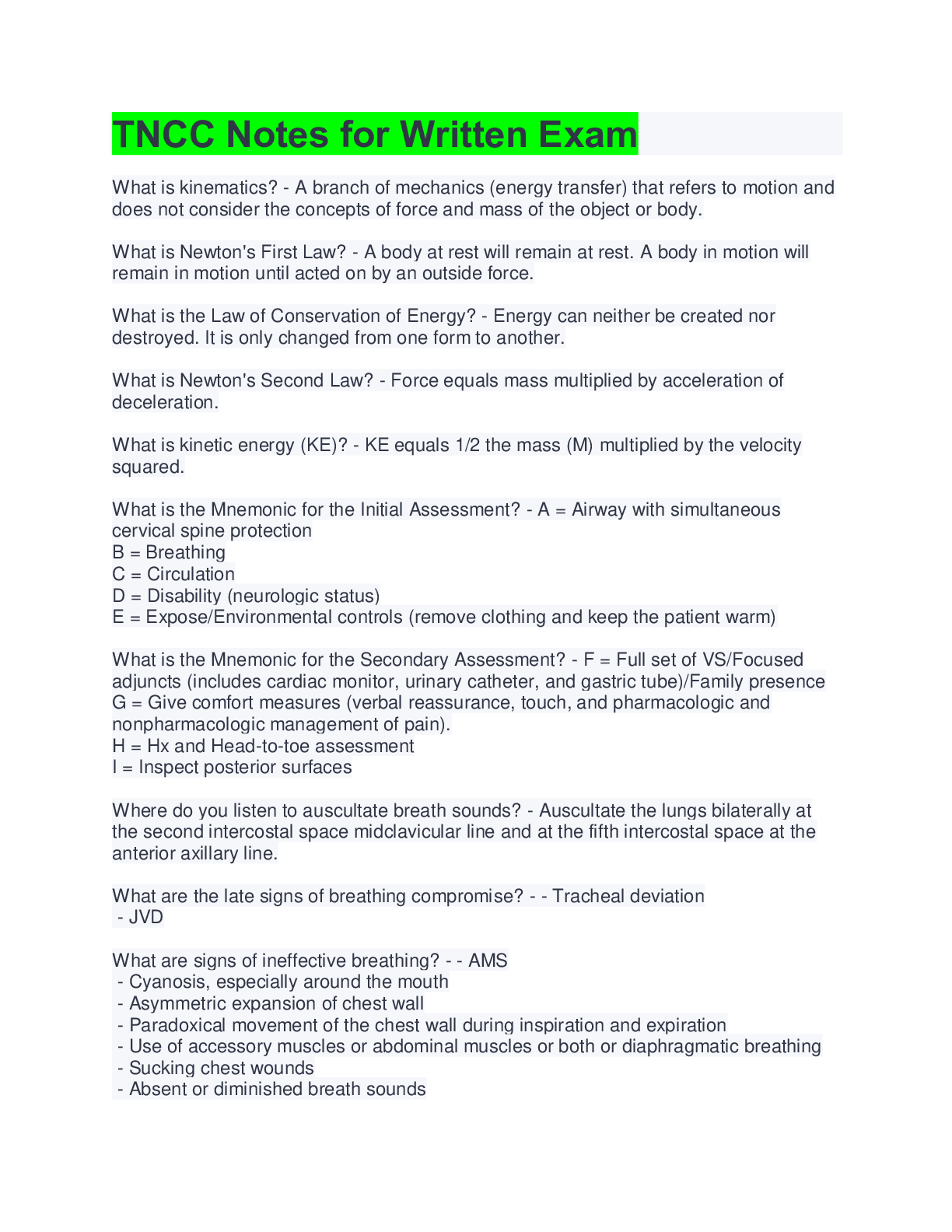

.png)
.png)
.png)

